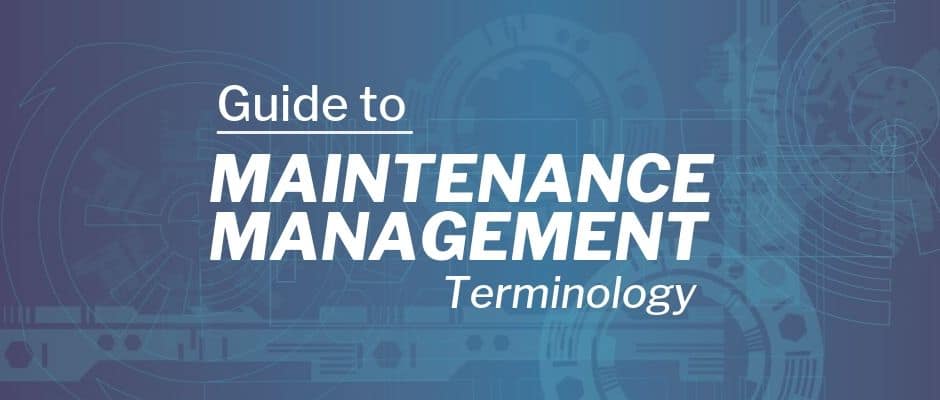It’s easy to become overwhelmed with the vast amount of terminology used to describe maintenance concepts. Even those who are familiar with various maintenance terms know there is a lack of consistency among sources. This guide to maintenance management terminology serves to help teams better understand the differences between key phrases used in the industry. Browse through our maintenance glossary below.
Downtime is the amount of time a piece of equipment is not in operation (either planned or unplanned).
Uptime is the amount of time a piece of equipment is continuously operating in its intended manner (opposite of downtime).
Proactive Maintenance is the process of taking proactive measures before a piece of equipment malfunctions in hopes to eliminate a future breakdown (opposite of reactive maintenance).
Reactive Maintenance is the process of responding to unplanned equipment failures with actions taken to repair the defect that caused the breakdown.
Preventive Maintenance (PM) consists of periodic tasks aimed to keep assets in working order and prevent unscheduled downtime (a form of proactive maintenance).
Corrective Maintenance (CM) consists of actions taken to correct a problem with an asset and return it to normal operating condition (opposite of preventive maintenance).
Predictive Maintenance (PdM) is a type of maintenance strategy that utilizes the condition of assets to predict when maintenance is needed.
Condition-Based Maintenance consists of tasks performed as a result of quantitative data pertaining to the condition of an asset (vibration, pressure, etc.) in real time, commonly obtained through the use of sensors.
Reliability-Centered Maintenance (RCM) is the type of strategy used to optimize reliability for a particular asset by maximizing all facets of performance at the least cost possible.
Root Cause Analysis (RCA) consists of a systematic series of tasks aimed to identify the fundamental reason why a failure occurred.
Computerized Maintenance Management System (CMMS) refers to a software suite of components that help staff identify maintenance procedures, maintain critical parts inventory, and provide a mechanism for work to be requested. The goal is to preserve the functionality and production capacity of equipment and prevent unexpected breakdowns.
Enterprise Asset Management System (EAM) refers to a software suite that identifies every asset within the enterprise and tracks each dimension of its financial and operational impact, all throughout its entire lifecycle.
Key Performance Indicators (KPIs) consist of a collection of reports and metrics used to provide a high-level overview of the performance of a business, process or asset. KPIs are usually presented in a dashboard fashion and widely distributed throughout an organization, so all stakeholders can get an instant snapshot of their progress towards performance goals.
Mean Time Between Failure (MTBF) is used to understand how long an asset runs, on average, before it has an unexpected breakdown. It’s calculated by taking the sum of time between all breakdowns and dividing it by the number of unexpected breakdowns. MTBF is among the earliest attempts to anticipate future failures.
Mean Time to Repair (MTTR) is used to understand how long (duration), on average, it takes to repair an asset. In simplest terms, MTTR is equal to the sum of repair times of an asset divided by the number of times it’s been repaired. There are many variations of the calculation based on when the repair is initiated (reported, all parts and tools gathered, mechanic start time, etc.) and when the repair is considered complete (mechanic finished, calibrated, tested, test run, back in full production and speed).
Maintenance, Repair and Operations (MRO) refers to a designation of what work and expenses are included to keep a plant or facility operating. It does not typically include any expense or time associated with the cost of goods or services sold.
Overall Equipment Effectiveness (OEE) is a calculation designed to demonstrate performance and utilization of a given asset or system. It is the product of the availability of the asset (total run time divided by total scheduled time) multiplied by its throughput efficiency (actual production time divided by the fastest throughput possible by design) multiplied by its quality (total net salable units divided by total units made). A perfect OEE is equal to 100 percent, meaning that the system operated every minute it was scheduled to run, the system operated at its projected throughput every minute it was on, and all of the product units it produced had zero defects.
Concepts mentioned in this maintenance glossary only begin to scratch the surface of key terms. For additional information on a variety of topics, visit our maintenance management blog. To learn how CMMS and EAM software can enhance your maintenance strategy, contact the DPSI sales team. Not only do we provide industry-leading maintenance management software, but we also offer training, project management, excellent customer support and many other benefits for our customers.
Contributor – Frank Harmuth, DPSI Professional Services Training Specialist




